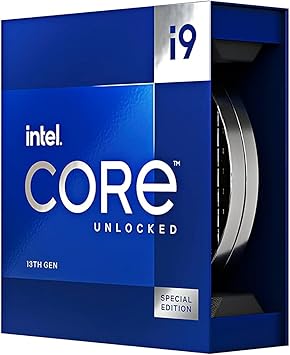Intel Core i9-13900KS

The Intel Core i9-13900KS is a powerful processor featuring 24 cores and 32 threads, capable of a maximum boost clock of 6.00 GHz. With a base clock speed of 3.20 GHz and support for up to 192 GB of DDR5 memory, it is designed for high-performance computing needs.
Popularity: Low
Performance:
Specifications:
Model: Intel Core i9-13900KS
Series: 13th Generation Intel® Core™ i9 Processors
Architecture: Raptor Lake
Socket: 1700
Cores: 24
Threads: 32
Base Clock: 3.20 GHz
Max. Boost Clock: 6.00 GHz
L2 Cache: 32 MB
L3 Cache: 36 MB
TDP: 150 W
Power Consumption: 295.0 W
Max Memory: 192 GB
Max Memory Speed: Up to DDR5 5600 MT/s, Up to DDR4 3200 MT/s
Max Temp: 100 °C
PCI Express Version: 5.0 and 4.0
PCIe Lanes: 20
Overclocking:
Integrated GPU: Yes
Cooler Boxed: no
Instruction Set: 64-bit
Launch Date: Q1'23
Manufacturer Page: Link
Review
The release of the Intel Core i9-13900KS marks a significant milestone in the realm of desktop processors. Built on Intel's 13th Generation Raptor Lake architecture, this processor is poised to captivate enthusiasts with its promise of extreme performance, featuring 24 cores, 32 threads, and an unprecedented 6 GHz maximum boost clock.
Performance Overview
The Intel Core i9-13900KS stands as a testament to Intel's engineering prowess, showcasing a combination of high core counts and remarkable frequencies. With 8 Performance (P) cores and 16 Efficiency (E) cores, the architecture accommodates a variety of tasks while maintaining top clock speeds. The processor's standout feature, the two P cores clocking up to 6 GHz, represents a leap previously unimaginable without exotic cooling methods such as liquid nitrogen [AnandTech].
Upon testing, the processor demonstrates noticeable improvements in single-threaded tasks, thanks to its advanced P-core turbo clock speeds. These higher frequencies translate to gains in performance benchmarks such as WinRAR encoding, where the i9-13900KS edges out its sibling, the Core i9-13900K, albeit by a margin [AnandTech].
Thermal and Power Considerations
A hallmark of the Intel Core i9-13900KS is its hunger for power and the thermal challenges that accompany it. Capable of drawing up to 360 watts, the processor tasks cooling systems with the immense challenge of dissipating heat effectively. As observed, even premium cooling solutions struggle, and custom water-cooling setups are recommended to fully harness the processor’s capabilities [TechPowerUp].
The core frequency performance is thermally throttled to balance heat generation and performance, sustaining a remarkable, yet demanding, operation that calls for significant power delivery and cooling infrastructure [AnandTech].
Overclocking Potential
Overclocking is accessible due to the processor's unlocked multiplier, although it comes with its own set of challenges. Users should remain cognizant of the thermal ceiling and requisite cooling strategies to extract extra velocity from their unit. As noted, the thermal limits can be raised, allowing ambitious users to chase higher overclocking figures, but with vigilance toward system temperatures [TechPowerUp].
Comparative Analysis
The comparison between the Intel Core i9-13900KS and its predecessor, the Core i9-13900K, reveals a pattern of diminishing returns on investment. The price premium of approximately $100 for the i9-13900KS yields performance that is only marginally superior, leading to considerations of whether the expense justifies the enhanced attributes [PCMag].
In most real-world applications, the performance is essentially analogous to the i9-13900K, with exceptions in specific single-threaded scenarios. However, this marginal advantage may attract those seeking to own the fastest processor currently available to consumers [PCMag].
Final Verdict
The Intel Core i9-13900KS is an impressive showcase of what current desktop processors can achieve, standing at the frontier of speed and capability. It is designed for enthusiasts who demand the absolute pinnacle of performance and possess the means to accommodate its operational demands.
In conclusion, while the KS processor offers an enticing peak into the future of computing performance, prospective buyers should weigh its incremental gains against its notable price point and accompanying cooling requirements. For those unfazed by these hurdles, the Intel Core i9-13900KS indeed promises a taste of cutting-edge processing power.
For further details on the architecture and technical specifications, visit the official Intel specifications page.